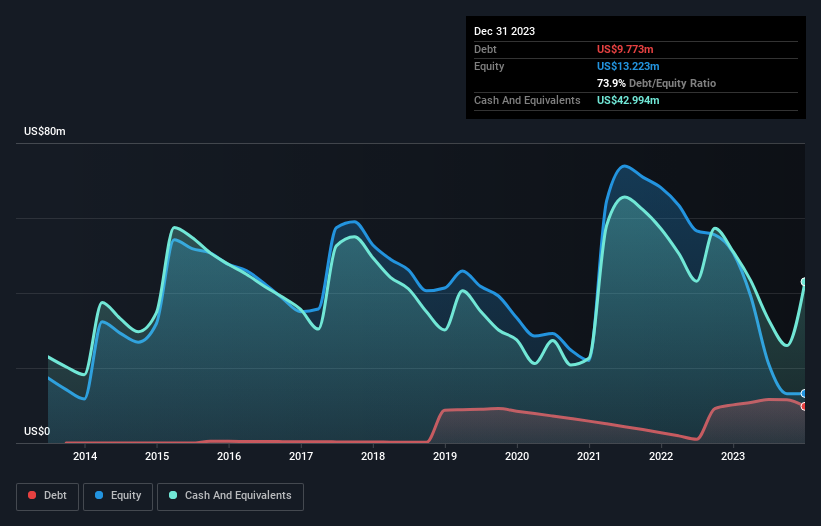Howard Marks put it nicely when he said that, rather than worrying about share price volatility, 'The possibility of permanent loss is the risk I worry about... and every practical investor I know worries about.' It's only natural to consider a company's balance sheet when you examine how risky it is, since debt is often involved when a business collapses. Importantly, BioLineRx Ltd. (TLV:BLRX) does carry debt. But the more important question is: how much risk is that debt creating?
When Is Debt A Problem?
Debt is a tool to help businesses grow, but if a business is incapable of paying off its lenders, then it exists at their mercy. In the worst case scenario, a company can go bankrupt if it cannot pay its creditors. However, a more common (but still painful) scenario is that it has to raise new equity capital at a low price, thus permanently diluting shareholders. Of course, plenty of companies use debt to fund growth, without any negative consequences. The first step when considering a company's debt levels is to consider its cash and debt together.
Check out our latest analysis for BioLineRx
What Is BioLineRx's Net Debt?
As you can see below, BioLineRx had US$9.77m of debt, at December 2023, which is about the same as the year before. You can click the chart for greater detail. But on the other hand it also has US$43.0m in cash, leading to a US$33.2m net cash position.

How Strong Is BioLineRx's Balance Sheet?
We can see from the most recent balance sheet that BioLineRx had liabilities of US$30.9m falling due within a year, and liabilities of US$19.9m due beyond that. On the other hand, it had cash of US$43.0m and US$1.19m worth of receivables due within a year. So it has liabilities totalling US$6.52m more than its cash and near-term receivables, combined.
Given BioLineRx has a market capitalization of US$70.7m, it's hard to believe these liabilities pose much threat. However, we do think it is worth keeping an eye on its balance sheet strength, as it may change over time. While it does have liabilities worth noting, BioLineRx also has more cash than debt, so we're pretty confident it can manage its debt safely. There's no doubt that we learn most about debt from the balance sheet. But ultimately the future profitability of the business will decide if BioLineRx can strengthen its balance sheet over time. So if you're focused on the future you can check out this free report showing analyst profit forecasts.
In the last year BioLineRx managed to produce its first revenue as a listed company, but given the lack of profit, shareholders will no doubt be hoping to see some strong increases.
So How Risky Is BioLineRx?
We have no doubt that loss making companies are, in general, riskier than profitable ones. And in the last year BioLineRx had an earnings before interest and tax (EBIT) loss, truth be told. Indeed, in that time it burnt through US$23m of cash and made a loss of US$61m. However, it has net cash of US$33.2m, so it has a bit of time before it will need more capital. Overall, we'd say the stock is a bit risky, and we're usually very cautious until we see positive free cash flow. There's no doubt that we learn most about debt from the balance sheet. But ultimately, every company can contain risks that exist outside of the balance sheet. We've identified 5 warning signs with BioLineRx (at least 1 which is potentially serious) , and understanding them should be part of your investment process.
At the end of the day, it's often better to focus on companies that are free from net debt. You can access our special list of such companies (all with a track record of profit growth). It's free.
Valuation is complex, but we're here to simplify it.
Discover if BioLineRx might be undervalued or overvalued with our detailed analysis, featuring fair value estimates, potential risks, dividends, insider trades, and its financial condition.
Access Free AnalysisHave feedback on this article? Concerned about the content? Get in touch with us directly. Alternatively, email editorial-team (at) simplywallst.com.
This article by Simply Wall St is general in nature. We provide commentary based on historical data and analyst forecasts only using an unbiased methodology and our articles are not intended to be financial advice. It does not constitute a recommendation to buy or sell any stock, and does not take account of your objectives, or your financial situation. We aim to bring you long-term focused analysis driven by fundamental data. Note that our analysis may not factor in the latest price-sensitive company announcements or qualitative material. Simply Wall St has no position in any stocks mentioned.
About TASE:BLRX
BioLineRx
A commercial stage biopharmaceutical company, develops and commercializes therapeutics for oncology and rare diseases.
Excellent balance sheet with moderate risk.
Market Insights
Community Narratives




